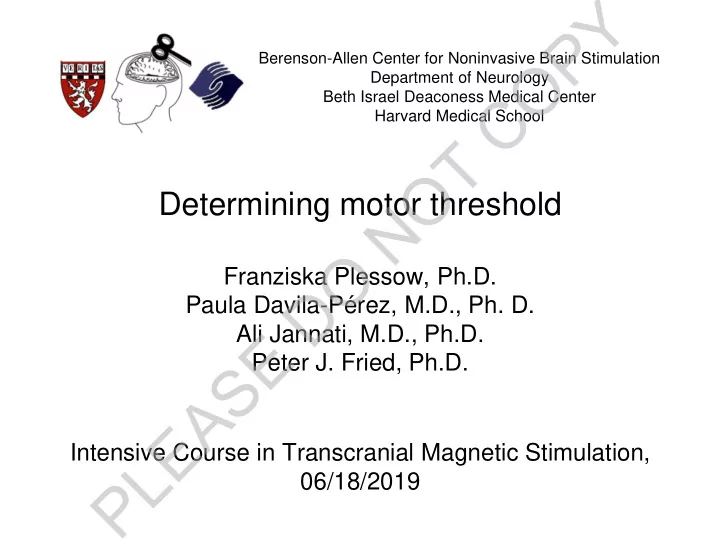

Y P O Berenson-Allen Center for Noninvasive Brain Stimulation Department of Neurology C Beth Israel Deaconess Medical Center Harvard Medical School T O Determining motor threshold N O Franziska Plessow, Ph.D. D Paula Davila-Pérez, M.D., Ph. D. E Ali Jannati, M.D., Ph.D. S Peter J. Fried, Ph.D. A E Intensive Course in Transcranial Magnetic Stimulation, L P 06/18/2019
Y P O Safety First!!! C T O N • Screen for contraindications and side-effects O D • Earplugs must be worn by subject and operator E S A E L P Determining motor threshold 2
Y P O Motor threshold (MT) definition C T O N The minimum intensity (% of maximum machine output) O to elicit a motor response in at least 50% of trials D E S A E L P Determining motor threshold 3
Y P O Role of MT C T Objective measure of relative cortical excitability/reactivity O N - Reflects voltage-dependent ion channel function O - Highest test-retest reliability of any TMS measure D Used to individualize intensity of further TMS E S Consistent with safety limits (Rossini et al., 2009) A E L P Determining motor threshold 4
Y P O Types of MT C T Resting motor threshold (RMT) > Active motor threshold (AMT) O N O D E S A E L P Determining motor threshold 5
Y P O Factors that influence MT C T Subject factors: O - Inter- and intra-individual variance N - Activity of brain/muscle - Coil-to-cortex distance O - CNS drugs D Physical Parameters: E - Device (stimulator and coil) S - Pulse waveform/shape/direction A - Navigated vs. Non-navigated TMS E - Method of determination (visible/EMG) L P Determining motor threshold 6
Y P O Methods of determining MT C T Visual inspection Electromyography (EMG) O N O D E Peak-to-peak MEP S MEP Amplitude latency A TMS Pulse E L P Determining motor threshold 7
Y P O RMT with EMG C T Rossini-Rothwell method: O Minimum intensity to elicit motor evoked potentials (MEPs) N of ≥ 50 μV peak-to-peak amplitude in ≥50% of consecutive trials (typically 10) O D E μV μV S A E L s s P Determining motor threshold 8
Y P O Target muscle C T O N O D E S A E L P Determining motor threshold 9
Y P O Penfield‘s motor homonculus C T O N O D E S A E L P Determining motor threshold 10
Y P O Attaching EMG electrodes C Identify T O N O Clean D E S A Attach E L P 11
Y P O Finding the “hot spot” with neuronavigation C T O N O D E S A E L P Determining motor threshold 12
Y P O Finding the “hot spot” without neuronavigation C T ≈5 cm lateral from the vertex O N O D E S A E L P (Jaspers, 1958) Determining motor threshold 13
Y P O Finding a starting location C T O N 7cm O 5cm D 5cm E S A E L P 14
Y P O Finding the “hot spot” C T 1. Set intensity to 30% and deliver a couple of pulses O 2. Go up in steps of 5-10% until MEPs are observed N 3. Deliver several pulses to ensure a consistent response is evident (suprathreshold) O 4. Test four spots around the location of the MEP D (north, east, south, west) E 5. Repeat Step 4 until the individual’s S “hot spot” is identified A E Whatever you do, do it consistently. L P Determining motor threshold 15
Y P O Finding the MT C T 1. Record 10 MEPs O 2. Progressively lower intensity (1-2%) until ≥5/10 trials elicit N an MEP of ≥50 μV (or visible twitch) 3. Always check 1 intensity lower O D E S A E L P 16
Y P O Finding the MT C T Alternatives under time constraints: O - ≥3/6 N - Adaptive MT determination/Parameter estimation by sequential testing (PEST) with the TMS Motor Threshold Assessment Tool O (clinicalresearcher.org) D Trouble shooting: E - No MEP detected (relaxation, AMT, silent period) S - MEP latencies = 20-30 ms A E L P 17
Y P O Phosphenes C T Visual percept not triggered by phototransduction (i.e., O rubbing your eyes, blow to the head, TMS to visual cortex) N O D E Eyes closed: phosphene Eyes open: scotoma S A Means to probe excitability of visual cortex (like MEPs) E Unlike MEPs, phosphenes are subjective L P Determining phosphene threshold 18
Y P O Phosphene hotspot/threshold C T Measure 2cm dorsal and 2cm lateral from the inion O Center the coil with handle pointing away from midline N Phosphenes should appear in contralateral visual field Increase intensity or move coil until phosphenes are reported O Assess phosphene threshold same as motor (i.e., 5 of 10) D E S A E L P Determining phosphene threshold 19
Y P O Safety First!!! C T O N • Screen for contraindications and side-effects O D • Earplugs must be worn by subject and operator E S A E L P Determining motor threshold 20
Recommend
More recommend